
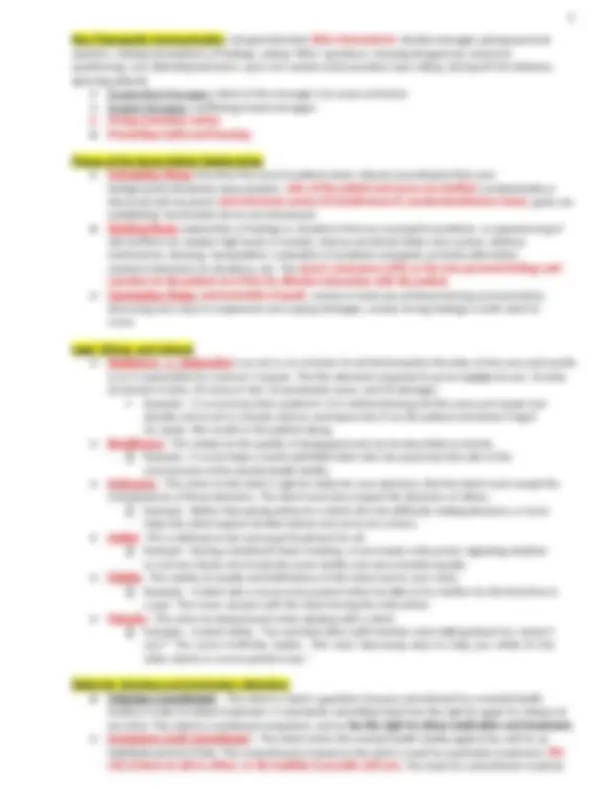
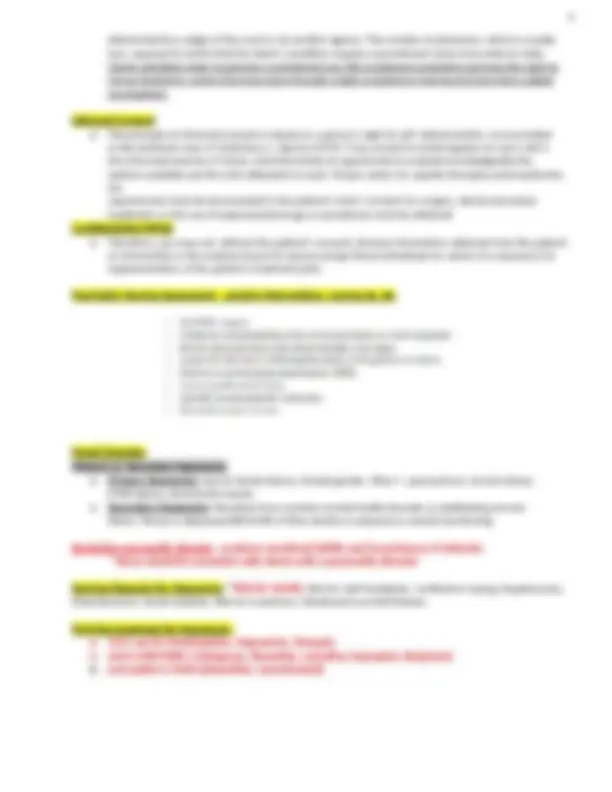
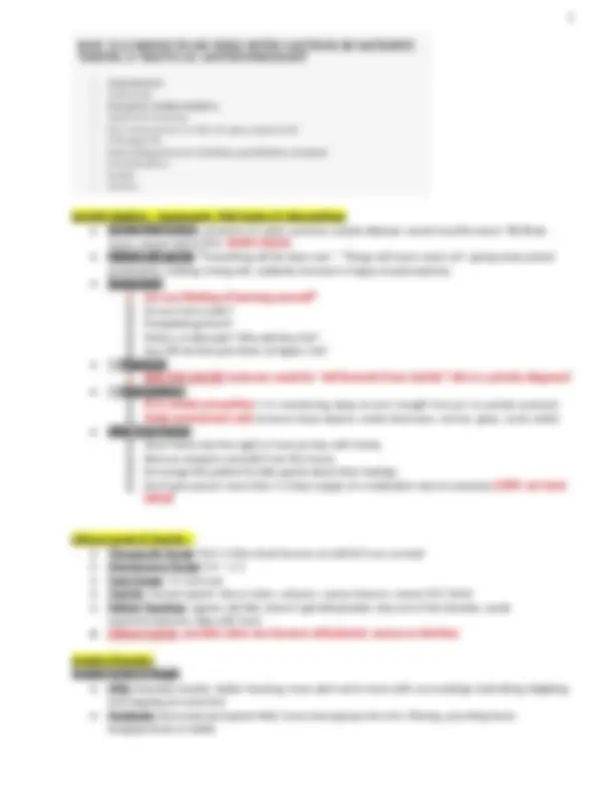
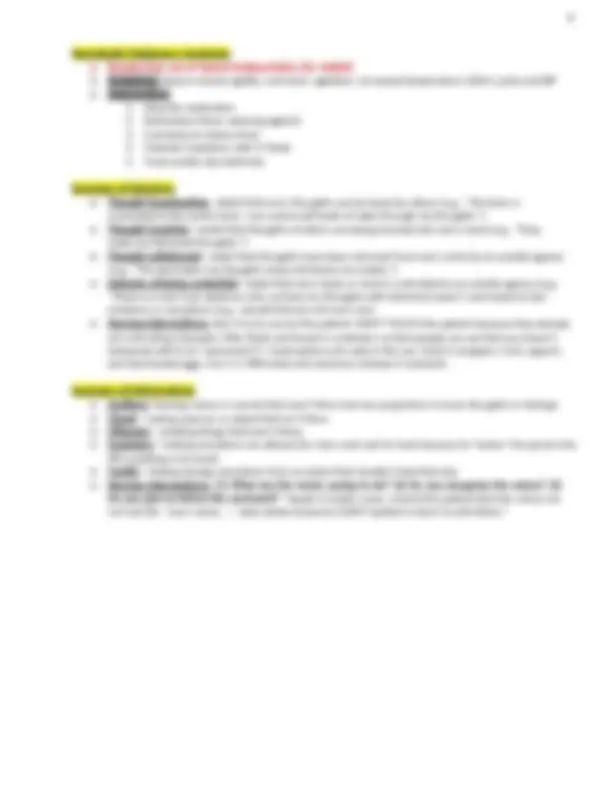
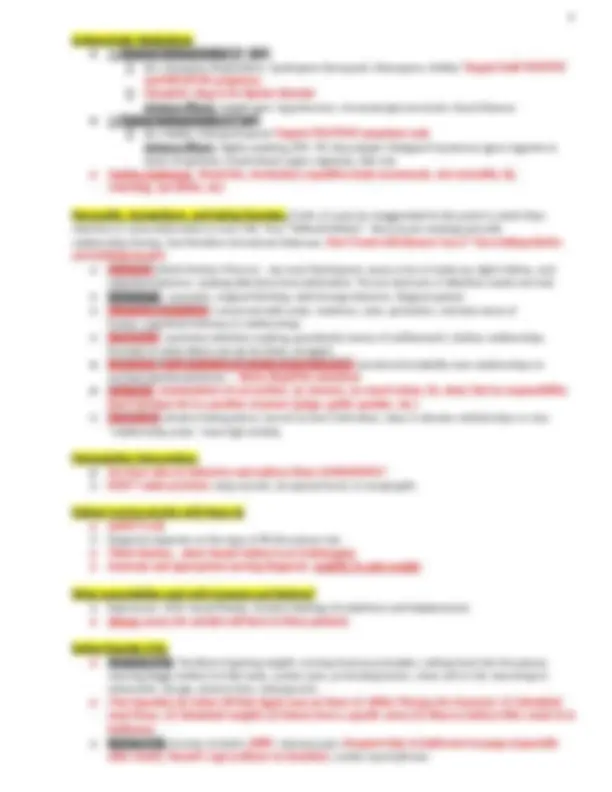
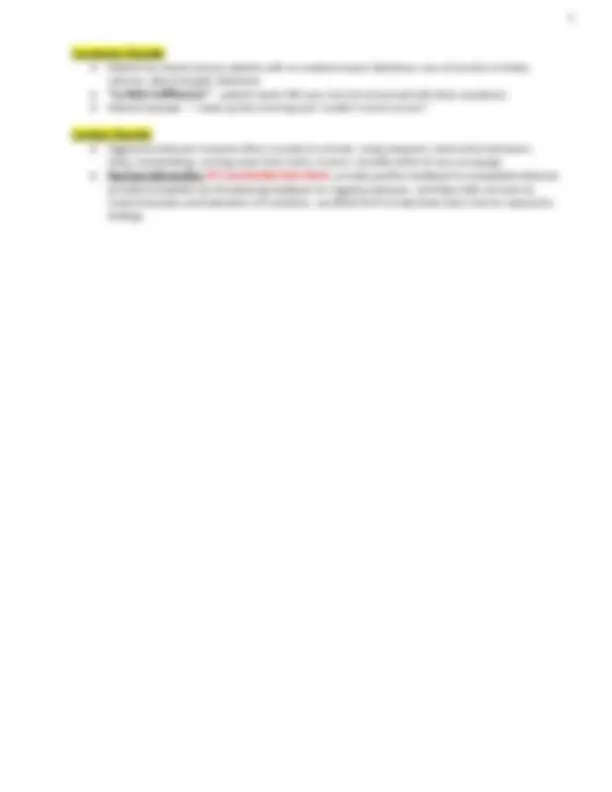
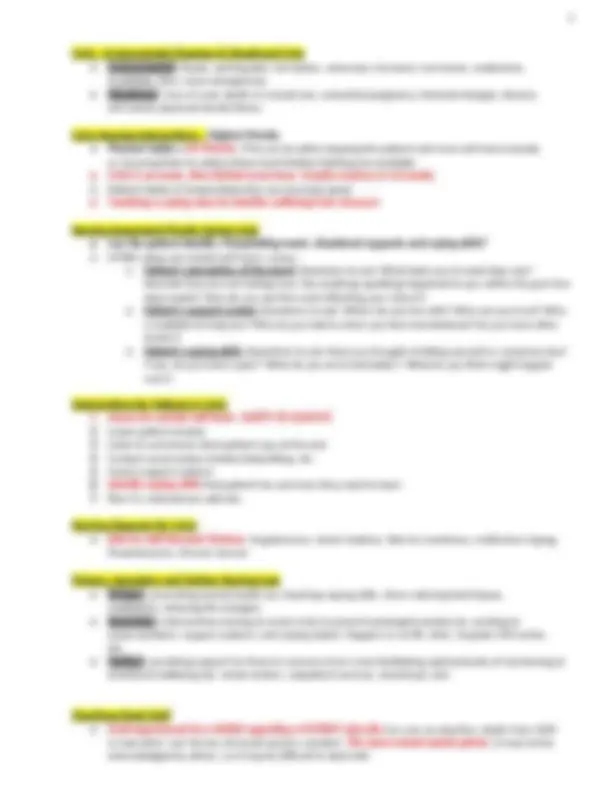
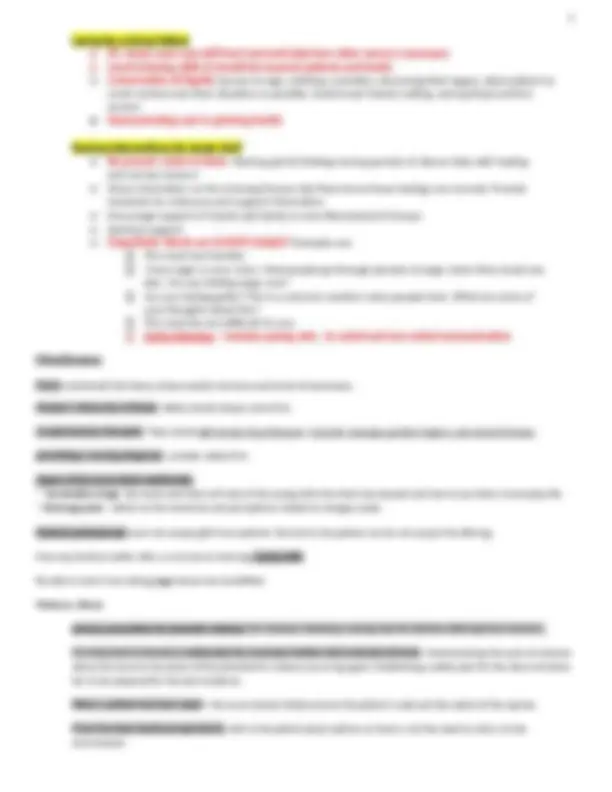
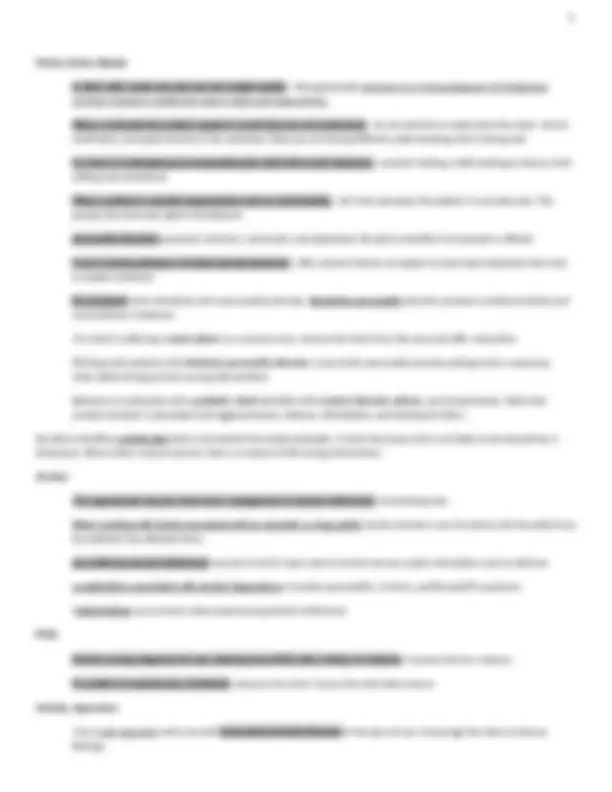


Study with the several resources on Docsity

Earn points by helping other students or get them with a premium plan


Prepare for your exams
Study with the several resources on Docsity

Earn points to download
Earn points by helping other students or get them with a premium plan
Community
Ask the community for help and clear up your study doubts
Discover the best universities in your country according to Docsity users
Free resources
Download our free guides on studying techniques, anxiety management strategies, and thesis advice from Docsity tutors
Mental Health FINAL EXAM Study Guide – A
Typology: Study Guides, Projects, Research
1 / 17

This page cannot be seen from the preview
Don't miss anything!










EBP (evidence based practice) Using the best available research evidence, clinical expertise, & patient preferences to make clinical decisions The 5 A’s of integrating best evidence into clinical practices includes : Asking Acquiring Appraising Applying Assessing The mental health recovery model is one of helping people with psychiatric disabilities effectively manage their symptoms, reduce psychosocial disability, and find a meaningful life in a community of their choosing. 3 specific areas are inherent within the art of nursing : caring, attending & patient advocacy. Basic Brain Anatomy- what do the different part of brain control? o Frontal Lobe: Thought Processes & Voluntary Movement (decision making) o Temporal Lobe: Auditory Processes (language, speech, connects to Limbic system) o Occipital Lobe: Vision (interprets visual images) o Parietal Lobe: Sensory & Motor (L/R orientation, reading, math, proprioception) o Hypothalamus: maintains homeostasis, regulates BP, Temp, libido, hunger, thirst, and sleep/wake cycles. o Cerebellum: Balance, Skeletal Muscle Coordination o Neurons: Nerves that translate electrical impulses into chemical signals released at the synapse Synapse- The space between neurons in which neurotransmitters are released and either inhibit/excite the adjacent neuron. The 4 NT’s are dopamine, norepinephrine, serotonin and acetylcholine. Milieu Therapy: Creating a SAFE, structured inpatient/outpatient setting where the mentally ill can test new behaviors and coping mechanisms with others. o Climate is essential to healing: paint color, relaxed environments are conducive to the healing process. o Florence Nightingale believed that the environment helps heal Maslow’s Hierarchy of needs o Basic Needs: food, oxygen, water, sleep, sex, and a constant body temperature. If all the needs were deprived, this level would take priority. o Safety Needs: Security, protection, freedom from fear/anxiety/chaos, and the need for law, order, and limits. o Belonging and Love Needs: intimate relationship, love, affection, and belonging, having a family and a home and being part of identifiable groups. o Esteem Needs: If self-esteem needs are met, we feel confident, valued, and valuable. When self- esteem is compromised, we feel inferior, worthless, and helpless. o Self-actualization: Reaching our full potential to feel inner peace and fulfillment. Peplau’s Theory of Interpersonal Relations o Created the Nurse-Patient Partnership increasing individual and family roles in recovery. (Based off of Sullivan’s Interpersonal Theory). Relationships greatly influence recovery Freud- contributed to psychiatric setting -Unconscious thoughts o Id – unconscious mind, instincts (this is dominant) o Ego – sense of self, use of defense mechanisms
o Superego – our conscious and is greatly influenced by our parents morals and ethical stances Erickson’s o Trust vs. Mistrust (infant 0- 1 ½) trust developed if caregivers give affection, love, care, attention, and reliability. (Feeding) o Autonomy vs. Shame (toddlers 1 ½ - 3) kids need to develop a sense of personal control. (Toilet Training) o Initiative vs. Guilt (children 3-6) children need to have power to explore their environment and not receive disapproval from parents. (Exploration) o Industry vs. Inferiority: (school aged kids 6-12) Kids dealing with new social and academic demands. Success leads to a sense of competence. (School) o Identity vs. Role Confusion (teens 12-20) Teens need to develop self-identity and personal identity to stay true to themselves. (Social Relationships) o Intimacy & Solidarity vs. Isolation (young adults 20-30 ) Young Adults need to form intimate, loving relationships. (Relationships) o Generativity vs. Self-Absorption: (adults 30-65) Need to create/nurture things by having children. (Work & Parenthood) o Integrity vs. Despair (elderly 65+) Need to look back and feel fulfilled by accomplishments; have wisdom and no regrets (Reflection on Life) Sullivan Personalities are influenced during childhood and mostly by the MOTHER. Therapeutic Communication: goal directed, professional, scientifically based. The goal is to get information so that you can plan care for the patient. o Active Listening Clarifying: promotes understanding of the patient’s statement Restating: repeating the same key words the patient has just spoken to echo their feelings. (Ex: If a patient remarks, “My life is empty…it has no meaning,” additional information may be gained by restating, “Your life has no meaning?”) Reflecting: helps people understand their own thoughts better; summarizes (Ex: For example, to reflect a patient's feelings about his or her life, a good beginning might be, “You sound as if you have had many disappointments.”) Exploring: use of open-ended questions or statements to allow the patient to express thoughts/feelings. (Ex: “Tell me more…”, “Give me an example of…”) Communication Technique Examples in Different Scenarios o For Suicidal Patients: “These thoughts are very serious Mr. Adams. I do not want any harm to come to you. Can you tell me what you were feeling and if there were any circumstances that led you to this decision?” o For Patients who start Crying : Stay with your patient and reinforce that it is all right to cry & offer tissues. “You seem upset, what are you thinking right now?” o For Patients who say they “don’t want to talk” : “Its alright. I would like to spend time with you. We don’t have to talk.” Or reapproach at a later time, “Our 5 minutes is up. I will be back at 10am and spend another 5 minutes with you.” o For Patients who ask the nurse to keep a secret: Nurses cannot make such promises, as it may be important to share that information with other staff for safety reasons. “I cannot make that promise Mr. Adams as it might be important for me to share it with the other staff”. o Non-Verbal: Tone of voice (tone, pitch, intensity, stuttering, silence, pausing) Facial expressions (frown, smile, grimaces, raises eyebrows, licks lips) Posture (slumps over, puts face in hands, taps feet, fidgets with fingers) Amount of eye contact (angry, suspicious or accusatory looks, wandering) Sighs/Hand gestures (fidgeting, snapping fingers) Yawning
determined by a judge of the court or by another agency. The number of physicians, which is usually two, required to certify that the client’s condition requires commitment varies from state to state. Clients admitted under involuntary commitment are still considered competent and have the right to refuse treatment, unless they have gone through a legal competency hearing and have been judged incompetent. Informed Consent o The principle of informed consent is based on a person’s right to self- determination, as enunciated in the landmark case of Canterbury v. Spence (1972): True consent to what happens to one’s self is the informed exercise of choice, and that entails an opportunity to evaluate knowledgeably the options available and the risks attendant on each. Proper orders for specific therapies and treatments are required and must be documented in the patient’s chart. Consent for surgery, electroconvulsive treatment, or the use of experimental drugs or procedures must be obtained Confidentiality/HIPAA o Therefore, you may not, without the patient’s consent, disclose information obtained from the patient or information in the medical record to anyone except those individuals for whom it is necessary for implementation of the patient’s treatment plan. Psychiatric Nursing Assessment – priority interventions, nursing dx, etc Mood Disorders Primary vs. Secondary Depression o Primary Depression : due to family history, female gender, 40yrs +, post-partum, chronic illness, ETOH abuse, stressful life events. o Secondary Depression: Resultant from another mental health disorder or debilitating chronic illness. Person is depressed BECAUSE of their decline in physical or mental functioning. **_Borderline personality disorder - produces emotional lability and inconsistency in behavior.
Suicidal Ideation – Assessment, Risk Factors & Interventions o Suicide Risk Factors: presence of a plan, previous suicide attempt, recent loss/life event, TBI/Brain Injury, recent visit to PCP, WHITE MALES. o Patient will say/do: “ Everything will be okay now”, “Things will never work out”, giving away prized possessions, making a living will, suddenly increase in happy mood/euphoria. o Assessment: Are you thinking of harming yourself? Do you have a plan? Precipitating Event? History of attempts? Why did they fail? Any MH dx that puts them at higher risk? o Diagnosis: RISK FOR SUICIDE (outcome would be “Self Restraint from Suicide”) this is a priority diagnosis! o Interventions: #1 is suicide precautions ( 1:1 monitoring, keep an arm’s length from pt, no suicide contract) Make environment safe (remove sharp objects, metal silverware, mirrors, glass, cords, belts) o After Crisis Period: Have friend stay the night or have pt stay with family Remove weapons and pills from the house Encourage the patient to talk openly about their feelings. Don’t give person more than 1-3 days supply of a medication due to overdose (SSRI’s are least lethal) Lithium Levels & Toxicity – o Therapeutic Range: 0.8-1.4 (fine hand tremors & mild N/V are normal) o Maintenance Range: 0.4 – 1. o Toxic Range : 1.5 and over o Toxicity: slurred speech, blurry vision, seizures, coarse tremors, severe N/V, thirst o Patient Teaching: regular salt diet, doesn’t get dehydrated, stay out of hot climates, avoid excessive exercise, take with food. o Lithium toxicity - possible when one becomes dehydrated, nausea or diarrhea. Anxiety Disorders Anxiety Levels & Stages o Mild: Everyday anxiety, better focusing, more alert and in-tune with surroundings (nail biting, fidgeting, foot tapping are common) o Moderate: Narrowed perceptual field, hears/sees/grasps less info. (Pacing, pounding heart, banging hands on table)
o Dependence on meds is HUGE. Don’t use a Benzo with a patient who has a history of drug abuse. Adverse Reactions: sedation, dry mouth, decreased cognitive function. Patient Teaching: increase fluids for dry mouth, don’t take if breastfeeding or if you have a drug abuse problem (ETOH too). Taper off the med. Take with or shortly after meals. Don’t take with Antacids, alcohol or caffeine. Defense Mechanisms o Altruism – emotional conflict are addressed by meeting the needs of others. o Sublimation – substituting something constructive for something they feel they lack or are inadequate at o Suppression – denial of something disturbing o Repression – forgetting/excluding unpleasant things from memory (forgetting a death of a parent, etc) o Displacement – transferring feelings from a particular person/event to something non-threatening (Boss yells at man man yells at wife wife yells at child child kicks the dog). o Undoing – compensation for a negative action, common in OCD (Ex: giving a gift to undo an argument. Washing hands frequently to reduce anxiety about dirty thoughts). o Somatization – turning anxiety into physical symptoms o Dissociation – the pain/anxiety is too much to deal with, so the patient dissociates to get away from it (an “out of body” experience). o Projection – blaming another PERSON for your own issues o Reaction Formation – unacceptable feelings are kept out of awareness by doing the opposite behavior (Ex: person who doesn’t like children becomes a boy scout leader) o Passive Aggressive – aggression towards others is expressed by procrastination, failure, and illness that affect others more than themselves. o Splitting – qualities of a person are either all good, or all bad – not a healthy mix. (either good, loving, nurturing or bad, mean, hateful). o Idealization – emotional issues are dealt with by exaggerated qualities to others (putting someone on a pedestal, AKA “the perfect man”). When other person doesn’t hold up to their idealization, they are disappointed. o Denial – ignoring the existence of realities (Ex: denying the diagnosis of cancer, even when presented with the lab work and diagnostics) Benefits of Buspirone o Less sedating than Benzodiazepines. Takes 3+ weeks to become effective (slow onset). o No physical dependence (patients who have drug abuse problems can safely take this medication). Patient Teaching: Taper off the med. Take with or shortly after meals. Don’t take with Antacids, alcohol or caffeine. o Side effects - Tardive dyskinesia. (Facial tics, involuntary repetitive body movements, not reversible, lip smacking, eye blinks, etc) o may be prescribed over diazepam as it does not result in physical dependence Thought Disorders Positive and Negative Symptoms of Schizophrenia o Positive: delusions, paranoia, hallucinations, unreal perceptions o Negative: flat affect, loss of joy (anhedonia), no motivation, laziness o Cognitive: cant concentrate, poor judgment, focus & memory impaired o Affective: hopeless, suicide ideations, inadequacy, poor social skills EPS/Tardive Dyskinesia o Tardive Dyskinesia: spasms of the mouth, tongue, lip-smacking, facial grimacing (not reversible, no antidote/cure) o Acute Dystonia: muscle stiffness (especially neck and head) o Akathisia: restlessness, pill rolling, pacing (rocking back in forth in a chair, shifting weight from side to side)
Neuroleptic Malignancy Syndrome o Results from use of Typical Antipsychotics (Ex: Haldol) o Symptoms: Severe muscle rigidity, confusion, agitation, increased temperature (103+), pulse and BP o Interventions :
Conversion Disorder o Patient has motor/sensory deficits with no medical reason (blindness, loss of function of limbs, seizures, abnormal gait, deafness). o “La Belle Indifference” – patient wants MD care, but not concerned with their symptoms. o Patient Example: “ I woke up this morning and I couldn’t move my arm” Conduct Disorder o Aggressive behavior towards others (cruelty to animals, using weapons), destructive behaviors, lying, manipulating, running away from home, truancy, sexually active at very young age o Nursing Intervention : #1 is protection from harm , provide positive feedback for acceptable behavior, provide immediate non-threatening feedback for negative behavior, and Help child use tools to control impulses and toleration of frustration, use ROLE PLAY to help them learn how to respond to feelings.
Addiction, Abuse and Violence Signs of Alcohol Withdrawal o Peak: 24-48 hours o Symptoms: hyper-alert, jerky movements, irritability , startles easy, “shaking inside”, tachycardia, sweating, increased: BP, HR , hallucinations , disorientated, agitation, small pupils o Seizures: 7hrs – 48 hours after stopping drinking o Complications associated with alcohol dependence: pancreatitis, cirrhosis, and Korsakoff’s psychosis Alcohol Dependence – know associated dx o Risk for Suicide, Risk for other-directed Violence, Hopelessness, Denial, Low-Self-Esteem, Anxiety o Depression & Alcohol go hand in hand. Nursing Interventions & Assessment tools o Keep them SAFE while they are withdrawing from drugs o BAL (blood alcohol levels) o Seizure precautions Medications for Alcohol Withdrawal o Chlordiazepoxide (Librium) – provides SAFE withdrawal and has anticonvulsant effects. Used for ACUTE withdrawal. #1st^ Choice Med o Disulfiram (Antabuse) – Used for MAINTENANCE. Makes you severely ill/sick if you drink alcohol. (Negative feedback) Metallic aftertaste. o Naltrexone (Revia)- Used to reduce cravings. Used in the first 12 weeks of ACUTE recovery. Interventions for Pre-Assaultive Patient o Respond early and consistently to angry/aggressive behavior o Leave door open, stay between the door and the patient (never let patient get between you and the exit!), low tone voice, talk slowly and calmly, appear calm & collected, ask “What will help now?”, sit at 45 degree angle to patient o Reintegration: gradual increase in the ability of the patient to handle stimulus. Cognitive and Degenerative Disorders Alzheimer’s - Understand Pathology o Slow deterioration. NOT REVERSABLE. Results in impaired memory (from death of neurons), judgment, agnosia, forgetfulness, inattention, Short Term Memory Goes First , “Sundowning”, Preservation (repetition of phrases or behaviors) o HEAD TRAUMA – Big influence in Dementia/Alzheimer’s!!! o Use Confabulation to fill in gaps of memory (putting truth and made up stores into the same sentence and they don’t know the difference) o 4 A’s of Dementia/AD: Amnesia, Aphasia, Apraxia, Agnosia Alzheimer’s – Meds used o Aricept (Donepezil) – slows down the deterioration/cognitive decline, but only for a short while. o Rivastigmine (Exelon)– slows down the deterioration/cognitive decline, but only for a short while. o Memantine (Namenda) – targets symptoms of Alzheimer’s disease in the moderate to severe stages. Stages of Dementia:
Crisis - Environmental Disasters & Situational Crisis o Environmental: floods, earthquakes, tornadoes, volcanoes, tsunamis, hurricanes, avalanches, mudslides, fires, snow emergencies o Situational: loss of a job, death of a loved one, unwanted pregnancy, financial changes, divorce, and severe physical/mental illness. Crisis Nursing Interventions – Highest Priority o Physical Safety is #1 Priority. (This can be either keeping the patient safe from self-harm/suicide, or securing them to safety where food/shelter/clothing are available. o Crisis is an acute, time limited occurrence. Usually resolves in 4-6 weeks. o Patient Safety & Anxiety Reduction are two basic goals o Teaching a coping class for families suffering from stressors Nursing Assessment Priority during Crisis o Can the patient identify: Precipitating event, situational supports and coping skills? o AFTER ruling out suicide/self-harm, assess:
Caring for a Dying Patient o #1: Assess your own skill level and seek help from other nurses is necessary o Good Listening Skills & Sensitivity towards patients and family o Conservation of Dignity (access to wigs, clothing, cosmetics, discussing their legacy, allow patient as much control over their situation as possible, food/music/friends visiting, and spiritual comfort access) o Demonstrating care to grieving family Nursing Interventions for Acute Grief o Be present. Listen to them. Sharing painful feelings during periods of silence help with healing and convey concern. o Share information on the Grieving Process (let them know these feelings are normal). Provide handouts for reference and support information. o Encourage support of friends and family or even Bereavement Groups o Spiritual support o Empathetic Words are ALWAYS helpful! Examples are: This must hurt terribly. I hear anger in your voice. Most people go through periods of anger when their loved one dies. Are you feeling angry now? Are you feeling guilty? This is a common reaction many people have. What are some of your thoughts about this? This must be very difficult for you. Active listening – includes paying attn.. to verbal and non-verbal communication Miscellaneous Freud contributed the theory of personality structure and levels of awareness. Maslow’s Hierarchy of Needs. Safety should always come first. complementary therapies. They would not include drug therapies. Consider massage, guided imagery, and animal therapy. prioritizing a nursing diagnosis , consider safety first. stages of the nurse-client relationship.
When caring for a patient with major depression , know that safety is a priority. co-morbid conditions associated with anorexia. Depression is common. anorexia and appropriate nursing diagnosis. inability to gain weight. Bulimia nervosa , certain situations trigger the urge to binge/purge. This is a high priority for nursing care plan. Identify statements that may trigger a primary nursing focus from a patient. For instance, a statement of hearing voices may trigger a primary focus. Dying. When working with family member of a dying patient , encourage family members to express emotions, provide information, and answer questions related to the care of the person. Meds. The first line treatment for depression (SSRIs) Know what drugs may be classified as SSRIs. If a patient starts suffering side effects w/an SSRI - such as agitation, confusion, fever, stop the medication and have the patient assessed. Feeling dizzy and weak when getting out of a chair is indicative of orthostatic hypotension , which is a common side effect of anti-anxiety medications such as Xanax. The nurse should instruct the client to rise slowly from the sitting to standing position to avoid dizziness. Consider using long-acting medications such as an injection for one that may be non-compliant with medication management. lithium toxicity is a possible when one becomes dehydrated. One with nausea or diarrhea may be at risk. side effects of risperidone. Tardive dyskinesia. (Facial tics, involuntary repetitive body movements, not reversible, lip smacking, eye blinks, etc) patient teaching for SSRIs (sertraline) Know it takes a few weeks for the drug to be effective. Buspirone may be prescribed over diazepam as it does not result in physical dependence. Clozapine. Know this drug is for bipolar disorder. Informed consent, Committed A patient is involuntarily admitted to a psychiatric unit for expressing violent tendencies to another , he/she cannot leave without medical or court approval. A patient who is admitted for suicide risk loses the right to privacy. Rights a patient retains when involuntarily admitted to a behavioral unit. For instance the patients retain the rights to informed consent and right to refuse medications. Understand informed consent. When providing Antabuse to a client, ensure the individual is cognitively able to understand the effects of ingesting alcohol while taking the drug. Be able to note when an individual with mental illness may require involuntary hospitalization. Consider safety as a priority to self and/or others. Communication.
Understand the concept of therapeutic and non-therapeutic communication. Do not limit the patient’s ability to express feelings. How to respond to someone that is critical of those with mental illness. Stop the dialogue if able When offering therapeutic communication , explore along with reflective listening. This draws out the client and can help the client feel valued, understood, and supported. For instance, ask “What happened to make you feel that way?” When offering therapeutic communication , ask questions and put into words what the client is referencing. If a client is feeling he/she is unable to talk to anyone or is not understood, ask the client if he/she feels misunderstood. non-therapeutic techniques of giving premature advice, giving reassurance, presenting reality, and focusing. Active listening includes paying attention to verbal and non-verbal communication. Empathy Consider/understanding the individual’s feelings and do not make personal statements. Make communication about the patient. Be willing to listen. Active listening - let the other person know you are listening by maintaining eye contact and nodding. It takes practice. Anger is not a helpful in caring for patients and may make being objective difficult. Show concern, empathy, and compassion. Therapeutic communication strategy for one experiencing auditory hallucinations. Address the patient directly about the hallucination. When one is suffering a crisis , consider the feelings of client and/or family first. One must be able to talk and express feelings/emotions. When a client is delirious and yells out at the nurse , respond with empathy and offer support such as staying with the client. Demonstrating care to a grieving family is important for a nurse to practice. Delirium vs Alzheimers. When one is experiencing delirium , orient the client to the day, place, and those around him. Do not attempt to explain or rationalize with the patient. When working with a patient with Alzheimer’s disease , provide routine and reminder signs. Neurotransmitters implicated in the development of Alzheimer’s disease. Acetylcholine and glutamate are factors. Always assess the safety of the client with dementia. Medications may cause unsteadiness. Restraints are not necessary if a patient is not agitated. Confabulation - used in a patient with Alzheimer’s. Agnosia – client does not recognize objects or understand what they’re used for, so the nurse should give the client concrete directions. Do not do the task for the patient. Tell the client what to do with the object.